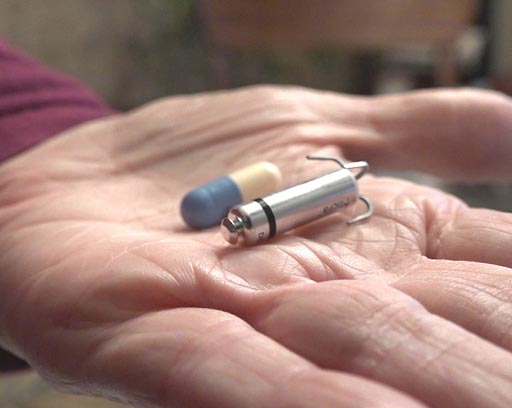Implanted Pacing System Attaches Directly to Heart
By HospiMedica International staff writers
Posted on 15 Feb 2017
A novel leadless pacemaker provides patients with advanced pacing technology at one-tenth the size of a traditional pacemaker.Posted on 15 Feb 2017
The Medtronic Micra Transcatheter Pacing System (TPS) is s a fully self-contained, miniaturized pacemaker designed to provide patients with bradycardia an advanced single chamber pacing technology via a minimally invasive approach. The size of a large vitamin capsule, it does not require electrical leads to deliver pacing therapy, attaching instead directly to the heart wall via small nitinol wires (tines) that hold the device and the electrodes in place.

Image: The Micra TPS alongside a vitamin capsule (Photo courtesy of Medtronic).
The Micra TPS is delivered via a percutaneous catheter through the femoral vein and positioned inside the right ventricle of the heart. It does not require a surgical “pocket” to be created under the skin, eliminating potential complications, and can be repeatedly repositioned to make sure heart activity and low electrical thresholds are optimal. Once positioned, the device responds to patients' activity levels by automatically adjusting therapy. The Micra TPS has an estimated 12-year battery life, and is approved for full body 1.5 and 3 Tesla scans magnetic resonance imaging (MRI) scans.
“Dating back to the development of the first external battery operated pacemaker more than 60 years ago, Medtronic has a long history of collaborating with clinicians to better understand the needs of patients, and then innovating new products to meet those needs,” said John Liddicoat, MD, senior vice president and president of the cardiac rhythm and heart failure division at Medtronic. “We're looking forward to working with physicians and educating implanters to extend the positive results of our global clinical trial experience to even more patients.”
“The device is small enough to be delivered through a catheter and implanted directly into the heart, providing a safe alternative to conventional pacemakers without the complications associated with leads,” said cardiologist Paul Schurmann, MD, of Houston Methodist Hospital. “The device also allows us to automatically adjust pacing therapy based on a patient's activity levels and another positive is the battery can last up to 10 years. I believe this gives us another tool to help save lives of patients with slow or irregular heart rhythms.”
Bradycardia is defined as a heart rate of under 60 beats per minute (BPM) in adults. It typically does not cause symptoms until the rate drops below 50 BPM. Symptoms include fatigue, weakness, dizziness, and at very low rates, fainting. Highly trained athletes may also have athletic heart syndrome, a very slow resting heart rate that occurs as a sport adaptation and helps prevent tachycardia during training.














.jpg)